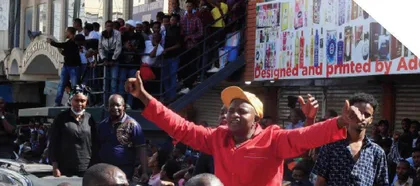The Rise and Impacts of Kenya’s Hustler Movement
作者: Zhang Weijie

On December 12, 2023, Kenya celebrated its 60th anniversary of independence. Since independence, Kenya’s political operations have long been characterized by tribal politics, and during the 2022 elections, United Democratic Alliance (UDA) presidential candidate William Samoei Ruto advocated a Hustler Movement with a platform focused on serving the interests of the underprivileged. The Movement, with its policy orientation of responding to the concerns of the hustler (refer to those forced to squeeze out a meagre living on the margins of society comparing to people from Kenya’s big-name families), seeks to move electoral politics away from the previous competition at the tribal and regional levels, and to construct an issue-oriented mode of political operation, which has given a new meaning to the development of Kenyan politics. Ruto became president in September 2022 after the Hustler Movement gained broad social support. Over the past years, the Ruto government has transformed the Hustler Movement’s policy ideas into a program of governance, reshaping Kenya’s political development agenda in practical terms. The influence of the Hustler Movement has become more and more visible, deeply reflecting the trend of Kenya’s political development over the past 60 years of independence.
The Rise of the Hustler Movement
Kenya, with a population of more than 54 million, is a typical multi-tribal country with more than 40 tribes, of which 17% are Kikuyu, 14% Luhya, 11% Kalenjin, 10% Luo, 10% Kamba, and the rest are smaller tribes. Since independence, tribal struggles have been a major thread in Kenya’s political evolution. Especially after the change to a multi-party system in 1991, the major political parties have all operated with more or less tribal overtones. The predominant tribal identity of political parties is a distinctive feature of Kenyan electoral politics. Politicians who run for office usually present themselves as tribal spokespersons in order to gain support from their own communities.
The Hustler Movement advocated by Ruto is different from the traditional mode of operation of Kenyan electoral politics in that it reshapes identity through social class affiliation. Ruto, who belongs to the Kalenjin ethnic group, once ran as a deputy to Uhuru Kenyatta, who is of Kikuyu origin, and won two presidential elections in 2013 and 2017. Ruto came from a poor family and was determined to keep climbing the ladder of life. He is still a self-proclaimed hustler person who believes that his personal success represents the glory of the underclass. In order to win the 2022 elections, Ruto is campaigning using Hustler Movement as the slogan, which has impacted and influenced the logic of Kenya’s traditional political narrative, which is centered around competition of tribal and regional interests.
The rise of the Hustler Movement reflects the complex reality of economic and social development in Kenya. Over the past 60 years of independence, Kenya’s overall development has been relatively stable, and its overall economic strength is among the highest in Africa, but the country’s per capita GDP is only about $2,000 U.S. dollars, and the gap between rich and poor in society is large. A study published by Oxfam International in 2022 showed that the number of Kenyans with personal wealth exceeding $5 million amounted to 1,755, with a total wealth of about $37.1 billion. Of these, the top two have assets totaling about $790 million and $750 million, respectively, which together exceed the total assets of more than 16.5 million ordinary Kenyans. In contrast, the majority of Kenyans have yet to see an improvement in their living conditions. An Afrobarometer survey of 2,400 Kenyans at the end of 2021 found that 85% of respondents felt that they had not benefited from the economic development, a rise of 30% compared to two years ago. It was with the aim of winning the majority of votes that Ruto came up with the Hustler Movement, which advocates for the interests of those at the bottom of the social ladder.
In the context of the Hustler Movement, hustler does not refer to all ordinary people. It has a specific connotation of those who have not been able to benefit from the previous development model, especially the youth. According to the Kenya Demographic Statistics 2019, 75% of the population is under 35 years of age. Typically, a youthful demographic implies an abundant labor force and a huge potential consumer market, which is seen as a dividend for the country’s development. However, unemployment in Kenya is relatively high, especially among the youth. Employment data for 2022 published by the Kenya National Bureau of Statistics shows an average unemployment rate of 5.8% and 19.5%, respectively, based on two different criteria: strict and broad. A British Council survey on the future development of Kenyan youth found that most of the young people do not attribute unemployment to themselves, but rather to the structure of the economy, the policy system and other factors: the country’s difficulty in providing enough jobs, the labor market’s unfairness and employment discrimination against youth. The concept of hustler in the Hustler Movement therefore has a narrative dimension and needs to be understood in the context of equity in the provision of development opportunities.